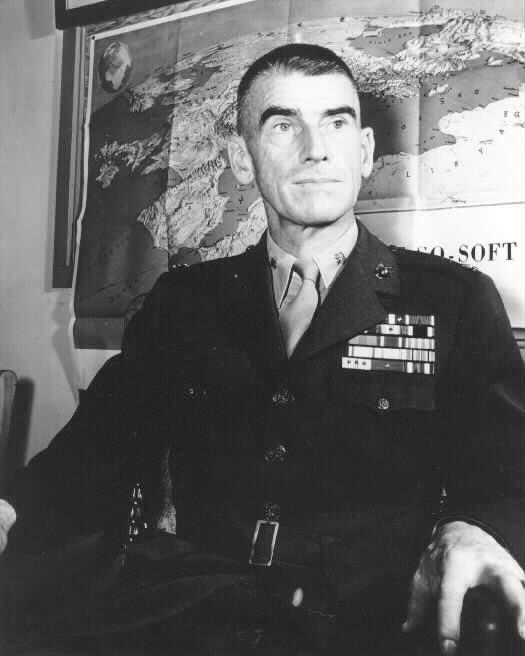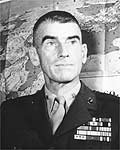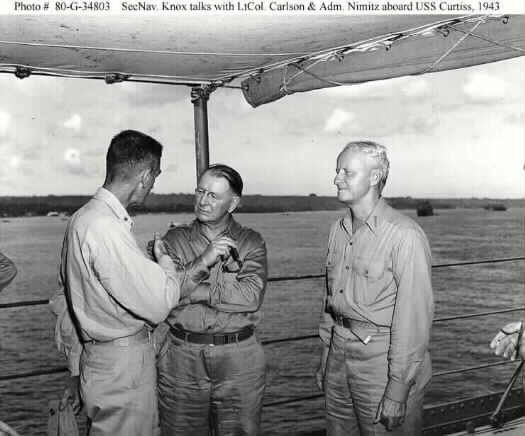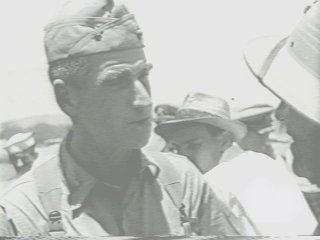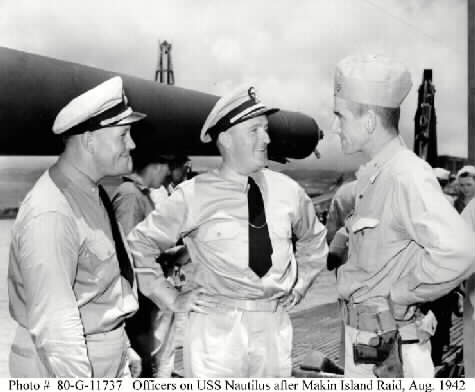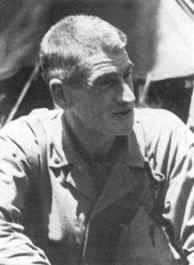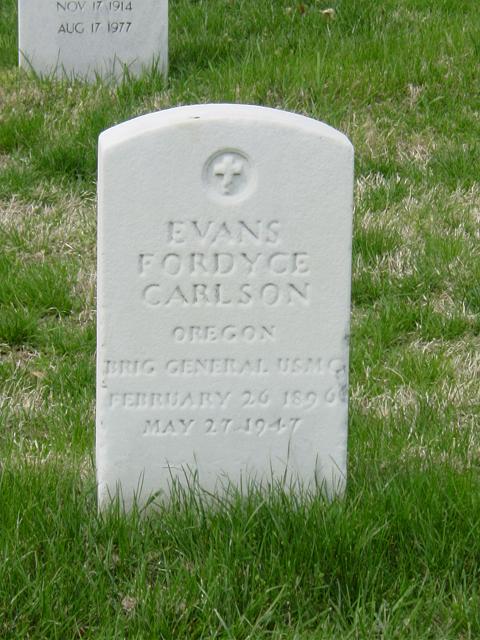Courtesy of the United States Marine Corps:
Brigadier General Evans F. Carlson, famed Marine leader of “Carlson’s Raiders,” was born 26 February 1896, at Sidney, New York. His father was a Congregationalist minister.
His long and colorful military career begin in 1912, when at the age of 16 he left high school and enlisted in the U.S. Army. When he finished his four-year enlistment he was a “top sergeant.” He had served in the Philippines and in Hawaii. He stayed out of uniform less than one year and returned in time for the Mexican punitive expedition.
During World War I he saw action in France, and was awarded the Purple Heart for wounds received in action. He was commissioned a second lieutenant in May, 1917, and made Captain of field artillery in December 1917. He served in Germany with the Army of Occupation.
His spectacular career as a Marine started in 1922 when he enlisted as a private. In 1923 he was commissioned a second lieutenant. After duty at Quantico, Virginia, he sailed for Culebra, Puerto Rico, in 1924 and remained there five months before being ordered to the West Coast for duty with the Pacific Fleet. Applying for aviation training in 1925, he went to Pensacola, Florida, for instruction, but subsequently returned to duty with ground units. He served another tour of foreign shore duty from 1927 to 1929 at Shanghai, China.
General Carlson was ordered to Nicaragua in 1930 as an officer in the Guardia Nacional. A first lieutenant at the time, he earned his first Navy Cross for leading 12 Marines against 100 bandits. He also was commended for his actions following the earthquake at Managua in 1931, and for performance of duties as Chief of Police in 1932 and 1933.
Returning to the United States in 1933, he was sent almost immediately to Shanghai. Shortly afterward he was transferred to the Marine Detachment, American Legation, Peiping, China, where he served as Adjutant and studied the Chinese language. In 1936 he returned to the United States via Japan. At home he served at Quantico while attending Marine Corps Schools, and studying International Law and Politics at George Washington University in Washington, D.C.
He went back to China for the third time, in 1937, as an official student of the Chinese language and as a military observer with Chinese forces. There he was afforded the opportunity to learn the tactics of the Japanese soldier.
Traveling thousands of miles through the interior of China, often on foot and horseback over the most hazardous terrain, he lived under the primitive conditions of native troops. When he left China in 1938, he was commended by the Commander in Chief of the Asiatic Fleet for his services.
He was so impressed with the danger of Japanese aggression in the Far East that in 1939 he resigned his commission as a captain in order to be free to write and lecture on that subject. When the danger he foresaw neared reality in 1941, he applied to be recommissioned in the Marine Corps and was accepted with the rank of major. A year later he was placed in command of the Second Marine Raider Battalion with the rank of lieutenant colonel. His leadership of that unit in the raid on Makin Island, 17 August 1942, earned him a Gold Star in lieu of a second Navy Cross. A second Gold Star was awarded him for heroism and distinguished leadership on Guadalcanal in November and December of that year.
Colonel Carlson was ordered back to the United States for medical treatment in the Spring of 1943, and subsequently returned to Tarawa as an observer. In that engagement he was cited for volunteering to carry vital information through enemy fire from an advanced post to division headquarters.
He was wounded during the Saipan operation while attempting to rescue a wounded enlisted man from a front line observation post, and was awarded a Gold Star in lieu of a second Purple Heart. Physical disability resulting from the wounds received on Saipan caused the General’s retirement on 1 July 1946.He was advanced to the rank of brigadier general on the retired list at that time for having been specially commended for the performance of duty in actual combat.
On 27 May 1947, the 51-year-old veteran succumbed to a heart illness at Emmanuel Hospital, Portland, Oregon. He had been living in Brightwood, Oregon, since his retirement. He was survived by his wife, Mrs. Peggy Tatum Carlson, and a son by a previous marriage, Evans C. Carlson.
In addition to the Navy Cross with two Gold Stars in lieu of a second and third award, and the Purple Heart with a Gold Star in lieu of a second award, Brigadier General Carlson was awarded the Legion of Merit; Presidential Unit Citation with three Stars; World War I Victory Medal with France Clasp; World War II Victory Medal; China Service Medal; Yangtze Service Medal; Expeditionary Medal; Italian Croix de Guerre; Nicaragua Presidential Order of Merit; Nicaraguan Medal of Distinction; Second Nicaraguan Campaign Medal; Asiatic-Pacific Campaign Medal with three Bronze Stars; American Campaign Medal; and the American Defense Service Medal.
Evans Fordyce Carlson got an early start in his career as a maverick. He ran away from his home inVermont at the age of 14 and two years later bluffed his way past the recruiters to enlist in the Army. When war broke out in 1917, he already had five years of service under his belt. Like Merritt A. Edson, he soon won a commission, but arrived at the front too late to see combat. After the war he tried to make it as a salesman, but gave that up in 1922 and enlisted in the Marine Corps. In a few months he earned a commission again. Other than a failed attempt at flight school, his first several years as a Marine Lieutenant were unremarkable.
In 1927 Carlson deployed to Shanghai with the 4th Marines. There he became regimental intelligence officer and developed a deep interest in China that would shape the remainder of his days. Three years later, commanding an outpost of the Guardia Nacional in Nicaragua, he had his first brush with guerrilla warfare. That became the second guiding star of his career. In his only battle, he successfully engaged and dispersed an enemy unit in a daring night attack. There followed a tour with the Legation Guard in Peking, and a stint as executive officer of the Presidential Guard Detachment at Warm Springs, Georgia. In the latter job Carlson came to know Franklin D. Roosevelt.
Captain Carlson arrived in Shanghai for his third China tour in July 1937. Again like Edson, he watched the Japanese seize control of the city. Detailed to duty as an observer, Carlson sought and received permission to accompany the Chinese Communist Party’s 8th Route Army, which was fighting against the Japanese.
For the next year he divided his time between the front lines and the temporary Chinese capital of Hangkow. During that time he developed his ideas on guerrilla warfare and ethical indoctrination. When a senior naval officer censured him for granting newspaper interviews, Carlson returned to the States and resigned so that he could speak out about the situation in China. He believed passionately that the United States should do more to help the Chinese in their war with Japan.
During the next two years Carlson spoke and wrote on the subject, to include two
books (The Chinese Army and Twin Stars of China), and made another trip to China. With war looming for the United States, he sought to rejoin the Corps in April 1941. The Commandant granted his request, made him a Major in the reserves, and promptly brought him onto active duty. Ten months later he created the 2d Raider Battalion.
After his departure from the raiders in 1943, Carlson served as operations officer of the 4th Marine Division. He made the Tarawa landing as an observer and participated with his division in the assaults on Kwajalein and Saipan. In the latter battle he received severe wounds in the arm and leg while trying to pull his wounded radio operator out of the line of fire of an enemy machine gun. After the war Carlson retired from the Marine Corps and made a brief run in the 1946 California Senate race before a heart attack forced him out of the campaign. He died in May 1947.
Courtesy of the United States Marine Corps:
BRIGADIER GENERAL EVANS FORDYCE CARLSON, USMCR (DECEASED)
Brigadier General Evans F. Carlson, famed Marine leader of “Carlson’s Raiders,” was born 26 February 1896, at Sidney, New York. His father was a Congregationalist minister.
His long and colorful military career begin in 1912, when at the age of 16 he left high school and enlisted in the U.S. Army. When he finished his four-year enlistment he was a “top sergeant.” He had served in the Philippines and in Hawaii. He stayed out of uniform less than one year and returned in time for the Mexican punitive expedition.
During World War I he saw action in France, and was awarded the Purple Heart for wounds received in action. He was commissioned a second lieutenant in May, 1917, and made Captain of field artillery in December 1917. He served in Germany with the Army of Occupation.
His spectacular career as a Marine started in 1922 when he enlisted as a private. In 1923 he was commissioned a second lieutenant. After duty at Quantico, Virginia, he sailed for Culebra, Puerto Rico, in 1924 and remained there five months before being ordered to the West Coast for duty with the Pacific Fleet. Applying for aviation training in 1925, he went to Pensacola, Florida, for instruction, but subsequently returned to duty with ground units. He served another tour of foreign shore duty from 1927 to 1929 at Shanghai, China.
General Carlson was ordered to Nicaragua in 1930 as an officer in the Guardia Nacional. A first lieutenant at the time, he earned his first Navy Cross for leading 12 Marines against 100 bandits. He also was commended for his actions following the earthquake at Managua in 1931, and for performance of duties as Chief of Police in 1932 and 1933.
Returning to the United States in 1933, he was sent almost immediately to Shanghai. Shortly afterward he was transferred to the Marine Detachment, American Legation, Peiping, China, where he served as Adjutant and studied the Chinese language. In 1936 he returned to the United States via Japan. At home he served at Quantico while attending Marine Corps Schools, and studying International Law and Politics at George Washington University in Washington, D.C.
He went back to China for the third time, in 1937, as an official student of the Chinese language and as a military observer with Chinese forces. There he was afforded the opportunity to learn the tactics of the Japanese soldier.
Traveling thousands of miles through the interior of China, often on foot and horseback over the most hazardous terrain, he lived under the primitive conditions of native troops. When he left China in 1938, he was commended by the Commander in Chief of the Asiatic Fleet for his services.
He was so impressed with the danger of Japanese aggression in the Far East that in 1939 he resigned his commission as a captain in order to be free to write and lecture on that subject. When the danger he foresaw neared reality in 1941, he applied to be recommissioned in the Marine Corps and was accepted with the rank of major. A year later he was placed in command of the Second Marine Raider Battalion with the rank of Lieutenant Colonel. His leadership of that unit in the raid on Makin Island, 17 August 1942, earned him a Gold Star in lieu of a second Navy Cross. A second Gold Star was awarded him for heroism and distinguished leadership on Guadalcanal in November and December of that year.
Colonel Carlson was ordered back to the United States for medical treatment in the Spring of 1943, and subsequently returned to Tarawa as an observer. In that engagement he was cited for volunteering to carry vital information through enemy fire from an advanced post to division headquarters.
He was wounded during the Saipan operation while attempting to rescue a wounded enlisted man from a front line observation post, and was awarded a Gold Star in lieu of a second Purple Heart. Physical disability resulting from the wounds received on Saipan caused the General’s retirement on 1 July 1946.He was advanced to the rank of Brigadier General on the retired list at that time for having been specially commended for the performance of duty in actual combat.
On 27 May 1947, the 51-year-old veteran succumbed to a heart illness at Emmanuel Hospital, Portland, Oregon. He had been living in Brightwood, Oregon, since his retirement. He was survived by his wife, Mrs. Peggy Tatum Carlson, and a son by a previous marriage, Evans C. Carlson.
In addition to the Navy Cross with two Gold Stars in lieu of a second and third award, and the Purple Heart with a Gold Star in lieu of a second award, Brigadier General Carlson was awarded the Legion of Merit; Presidential Unit Citation with three Stars; World War I Victory Medal with France Clasp; World War II Victory Medal; China Service Medal; Yangtze Service Medal; Expeditionary Medal; Italian Croix de Guerre; Nicaragua Presidential Order of Merit; Nicaraguan Medal of Distinction; Second Nicaraguan Campaign Medal; Asiatic-Pacific Campaign Medal with three Bronze Stars; American Campaign Medal; and the American Defense Service Medal.
Photos Courtesy of the United States Navy
To the Editor:
The August 18 news article about the burial of the remains of 13 Second Raider Battalion Marines killed in World War II didn’t mention their famous leader. The raid on Makin Island in the South Pacific in which they died was led by Lieutenant Colonel (later Brigadier General) Evans F. Carlson, who organized and trained the battalion known as Carlson’s Raiders.
Carlson learned from his experience as President Franklin D. Roosevelt’s personal correspondent with the Chinese Communist guerrillas in China in 1938 that every member of a military formation was important and should be treated equally. He brought a Chinese slogan, “gung ho” (work together), to the Marines.
The remains of the 13 marines now lie in Arlington National Cemetery along with those of General Carlson, who requested a gravestone no larger than the lowest private’s.
CHARLES M. GROSSMAN, M.D.
Portland, Oregon, August 20, 2001
The writer is chairman of the Evans F. Carlson Friends of the People’s Republic of China.
Navy Cross Citation for
Lieutenant Colone Evans F. Carlson, USMC
“For extraordinary heroism and distinguished service in actual conflict with the enemy in aggressive and successful conduct of a Marine Raider expedition against enemy-held Makin Island on August 17-18, 1942. As C.O. of the 2nd Marine Raider Battalion, he led his forces in the first operation of this type ever conducted by U.S. forces. While under fire of ground troops and aerial bombing, he personally directed his forces which inflicted great personnel and material damage on the enemy. In the withdrawal of his forces under adverse sea conditions he showed outstanding initiative, resourcefulness, and perseverance in evacuating all wounded and disabled men. Overall he displayed splendid leadership and untiring efforts in organizing, training, and taking his Marine Raider unit into successful action with courage and resourcefulness, against an unexpectedly powerful enemy force. After overcoming all opposition and destroying all gasoline storage, important shore installations, and two enemy aircraft, he successfully withdrew his unit. His outstanding bravery, skill, and determination in attacking this strong enemy force, with utter disregard for his personal safety, are in keeping with the highest traditions of the naval service.”
CARLSON, EVANS FORDYCE
BRIG GEN USMCR RET
VETERAN SERVICE DATES: Unknown
DATE OF BIRTH: 02/26/1896
DATE OF DEATH: 05/27/1947
DATE OF INTERMENT: 06/04/1947
BURIED AT: SECTION 11 SITE 653
ARLINGTON NATIONAL CEMETERY
Michael Robert Patterson was born in Arlington and is the son of a former officer of the US Army. So it was no wonder that sooner or later his interests drew him to American history and especially to American military history. Many of his articles can be found on renowned portals like the New York Times, Washingtonpost or Wikipedia.
Reviewed by: Michael Howard

